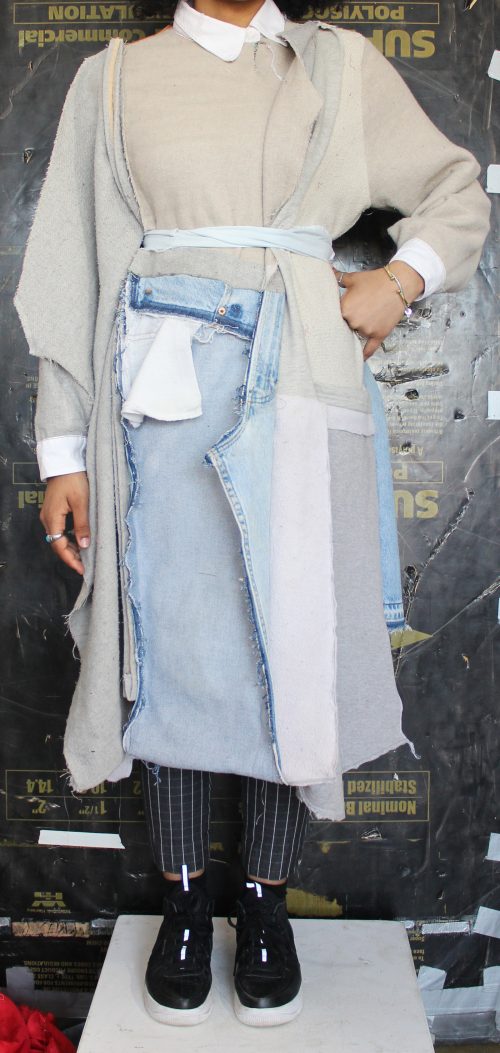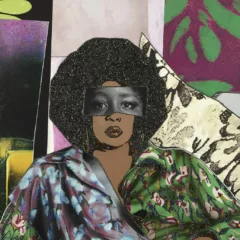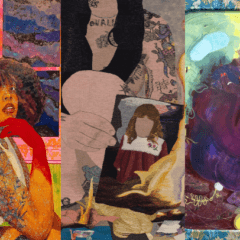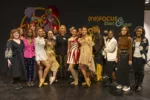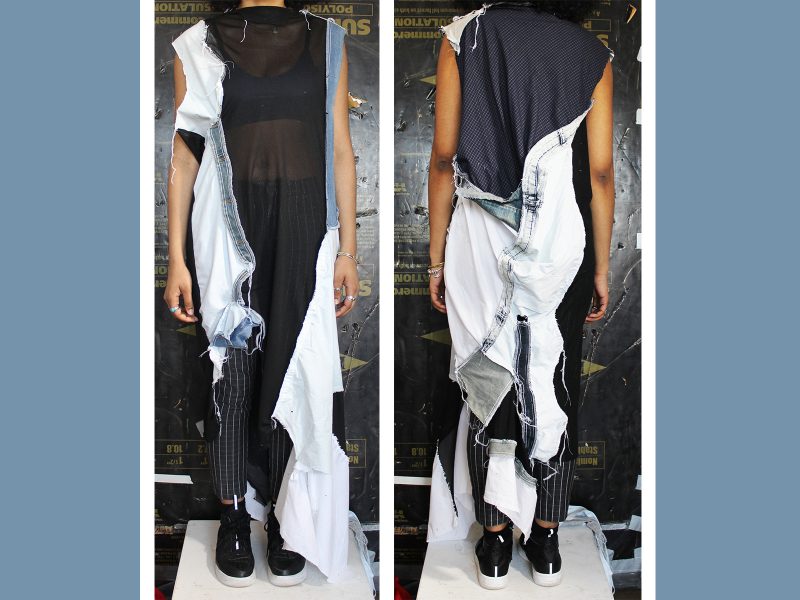
Fashion and design and its intersection with queer cultural sensibilities is having a much needed, painstakingly earned moment–in 2019, we are seeing an explosion of gender-fearless and empowering play in design, technique, and styling on an increasingly mainstream level moreso than ever before. Considering it has always been LGBT folks– and by and large, LGBT people of color–who have been at the forefront of fashion’s most daring moments, it’s curious that until recently gender-bent and gender-inclusive fashion was embraced so emphatically by New York, Paris, and Milan. But here we are: backless (and frontless) midriffs, wide-legged trousers, and an array of neons, pinks, and chartreuses decorate both the runways as well as the racks, in both women’s and menswear, and fashion is a lot better for it.
Enter Noél Puéllo, a fabric arts graduate of Tyler School of Art in fiber materials and Mass Art in fibers whose inter-disciplinarian approach to garment making pushes the boundaries between unisex workwear and avant garde design until those boundaries are imperceptible. “I’m always thinking of how I can make things genderfluid, genderqueer,” says the rising Afro-Latina design powerhouse. “Always thinking of how I can mix luxury with accessibility, keeping the deconstructed elements but adding other things that will make it exist in design and fine arts circles.” This essentially describes the nature of Puéllo’s work. She takes found or donated fabrics, misshapen scrapes and re-imagines them, sometimes combining similar fabrics– like, say, two large thrifted men’s dress shirts with thin vertical stripes in roughly matching color schemes– and combines them; the results are often oversized, elegant pieces that retain the heft and utility of workwear, the versatility and wearabilty of techwear, and the total look of complete extravagance.
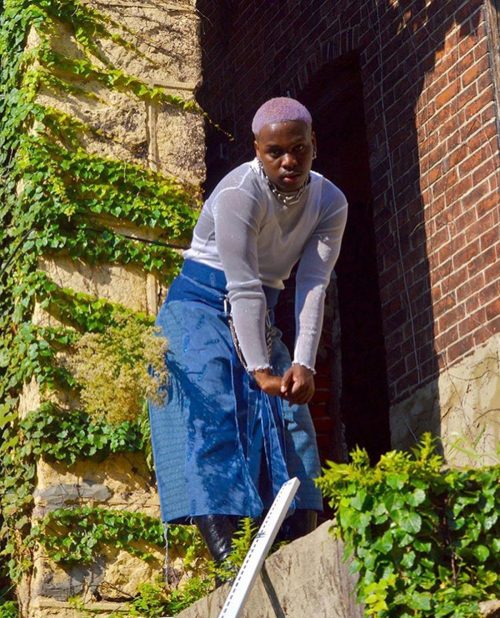
“My work stems from a place of survival and accessibility,” she affirms, explaining her affinity for oversized, dramatic clothing that presents the wearer with a dynamic range of wearability. In Puéllo’s world, two large sweatshirts from Foreman Mills are combined, both neckholes present (one casually circling the shoulder), the piece turned into an elegantly fashioned garment in size 3X; fabrics are stitched together from her small in-house studio where silk scraps from Fashion Row are woven elegantly into neoprene and canvas tarps to make day bags. “In my household [growing up] our main clothing stores are Goodwill or Savers, we are a low-income Afro-Latinx family with 5 kids going back to school at the same time. All of us growing so quickly in and out of clothing, we had to be super economical with our purchases. But at some point as I became bigger and taller, the only availability to my body size was very basic men’s button ups. But I longed for the goodwill hauls that my thinner friends were able to snag. They were able to shop in the designer clothing section or able to fit into all of the glitter and glam of the 80s and 90s.”
While the body-inclusive, gender-empowering/defining/defying clothing items she creates are themselves works of art, Puéllo’s worldview can’t be contained in a handful of shirts and dresses or a pair of men’s trousers. She’s shown at galleries like Vox Populi, work that, unlike her clothing, is wrought with tension. Often loose, tattered and ripped fabric will be juxtaposed with rusting coffee cans, plastic grocery bags and even condoms, often covered in paint or curry powder. There’s a tug between the duality of traditional Afro-Latinx experiences and perhaps the artist’s city-drenched perceptions and a reluctant embrace of a distorted future that plays out in these structures. While the aesthetic quality and overall adherence to thrift is still present, there’s a more vehement sense of urgency in the fine art and sculptural pieces. “To be 100% honest, I don’t think I look at fashion very much for inspiration in my making,” Puéllo says. “I went to school to study fiber and materials studies, not fashion, so my inspiration mostly comes from artists such as David Hammons, El Anatsui, Sonya Clark, and Doris Salcedo, artists who are interested in the manipulation of abundance, recycled materials, and people who are interested in challenging the way you see an object. I want to challenge the way we see cloth on bodies, moving beyond just the design realm.”
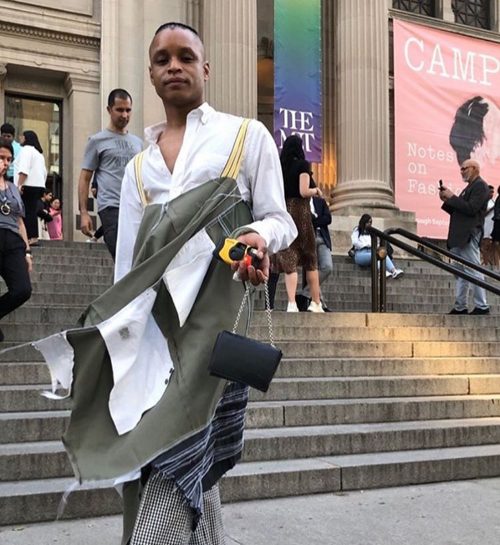
It hasn’t been an easy road to success and still there are challenges. As a queer Latina, Puéllo found navigating academia and the institutional structure of the art world arduous. There was the constant feeling of being boxed-in or classified that didn’t match Puéllo’s ardently anarchic spirit. Coming into wearable fashion late in her studies, Puéllo found that both fashion and the fine art world were not avenues that could contain the entirety of her expression while also combating systemic racism and racialized microaggressions on a near daily basis. “It was a constant struggle being in an all-white space with mostly white professors and white colleagues to get people to, one, understand what your work is about and two, to get professors to stop talking about the [perceived] “easier” oppressions such as queerness [simply] because they can relate.” Even when given space, often, as she cites, because of her lighter skintone, Puéllo believes “it’s a double-edged sword because you’re given access to the space which makes making easier but no one wants you there, or understands what you’re making, or only thinks you’re there because of affirmative action– yes, I have been told that three times since I’ve been in school.”
Even now, despite some successes, Puéllo, like many of Philadelphia’s genius artists of color, faces the hardship of exclusion. Fortunately, her works serves demographics whose own artistic ingenuity can be heightened by her designs. She’s outfitted folks from the likes of the queer Baltimore rapper and experimental musician Abdu Ali in several wildly expressive looks to the multi-cultural queer artist collective The Haus of Glitter Dance Company. “My goal first and foremost is to make couture clothing (or body sculptures) for low-income Black and brown people, especially for my trans sisters,” she says when asked about the necessity for keeping her works on a sliding scale. “Of course, I make everything available to everyone but my people are at the forefront of my thoughts when making garments because some of us might never be able to get access to the Pyer Moss, OFF WHITE, or the Brother Vellies of the world. I want everything I make to be accessible and you find can so much in the $1 bin at Philly Aids Thrift and really make something beautiful out of nothing. This makes me feel like I’m making [clothing] in the most ethical way that I can and still making some bomb ass pieces.”
More Photos

